Hurtigruten review: A breathtaking Norway coastal cruise
I wanted to take a cruise. My husband steadfastly refused to consider a cruise, but he wanted to see Scandinavia. Our compromise: a Hurtigruten cruise up the coast of Norway.
Disclosure: I received a media rate for this cruise: a discount, which makes this a sponsored post. Nevertheless, all opinions are my own and the Hurtigruten company has no influence over what I choose to write.
Another disclosure: This article contains affiliate links. If you click on one and make a purchase, I will receive a small commission. This will not affect your price.
Last updated: September 23, 2025.
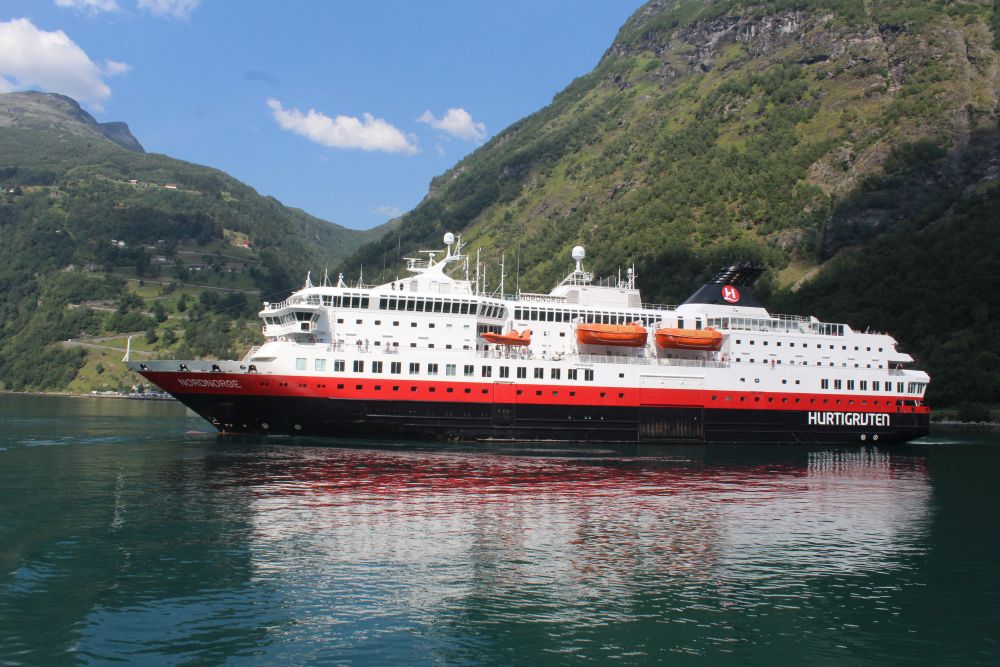
Use this table of contents to jump to whatever information you need.
While Hurtigruten cruises leave from Bergen every day of the year, we left in late July, and were “fortunate” to catch a period of above-normal temperatures and unusually clear skies. I put “fortunate” in quotation marks because our good weather coincided with record-breaking heat across Europe: the effects of climate change.
Stopping at 34 ports along the way, the cruise takes six days to travel from Bergen in southern Norway to Kirkenes in the far north, near the Russian city of Murmansk. It then travels more or less the same route south again (but with “only” 31 stops). In our case, we took the cruise north, carrying our car in the cargo hold, so we could take a road trip south again through Finland and then Sweden.
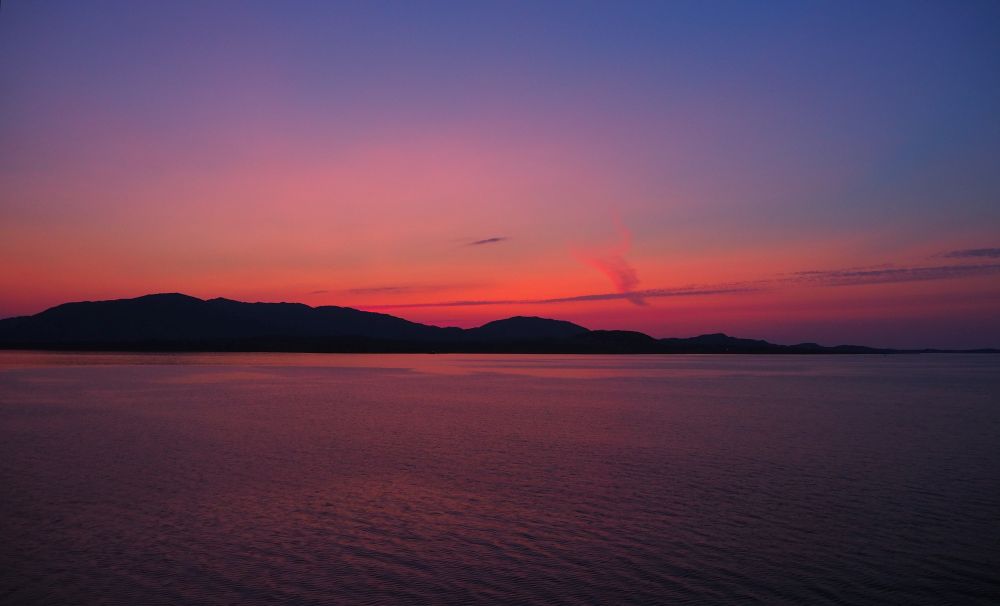
For us, this unusual weather meant clear and absolutely breathtaking views and balmy temperatures even past the point when we crossed into the Arctic Circle. At 11 at night, under the setting sun that resembles the moments before dawn, I wore short sleeves and shorts out on the deck, too enamored of the scenery to go to bed. We only got “normal” weather on the last day, as we moved over the top of Norway above 71° latitude. There, clouds gathered, the sea got rougher, and the temperature dropped.
Hurtigruten history
The original Hurtigruten ships were purely mail and cargo steamships. The first one sailed the route north once a week starting in 1893, billing itself as Hurtigruten, which means “fast route.” It moved up and down the coast, delivering mail and cargo to isolated villages along the way. Within a few years of the company’s launch of the first steamship route, it added a second steamship for travel to Spitsbergen, for adventurers.
Since then, the company has expanded so that a ship leaves Bergen every day and makes the trip north in six days, then back south over six more days. While the ships it now uses are small cruise ships, it is still a working ship, fulfilling its function of delivering mail and cargo to all of the ports along the way.

Each Hurtigruten ship is different. We traveled on the MS Nordnorge, which was built in 1997 and refurbished in 2016. It can carry 452 cabin passengers. All of their ships are a similar size, though some are much newer. Some ships – and more of them in the future – reflect Hurtigruten’s move to hybrid power to reduce the environmental impact of their ships. If you are looking for a trip on a hybrid ship, book the MS Kong Harald, the MS Nordlys or the MS Richard With.
The company split recently into Hurtigruten, which runs the original routes along the coast and to Spitsbergen, and HX Hurtigruten, which operates a range of “expeditions” to places like Antarctica and the Arctic.

A Hurtigruten voyage is a cruise, but not like you probably picture a cruise. So what is a Hurtigruten cruise like? Here are all the details:
Boarding your Hurtigruten ship
We found the boarding procedure to be efficient and smooth, though it took a long time before my husband could take the car on board. Everyone involved in getting us all aboard and settled in was very professional and friendly. Passengers drop off luggage at the Hurtigruten terminal and are free to explore Bergen for several hours or go ahead and board the ship. Cabins are available from 18:00 and by then, luggage has been delivered to the appropriate cabin door.
Passengers receive a card to open the cabin, but it serves also as a payment card anywhere on board, linked to a credit card. That makes it easy – perhaps too easy – to spend extra money beyond the almost-all-inclusive rates for cabin and meals.
The MS Nordnorge
Our ship, the MS Nordnorge, is tastefully and sleekly decorated, without any glitz. In the bow (the front) of the boat on level 7 is a panorama lounge with huge windows and comfy chairs to sit and watch the scenery. Other comfy seating and huge windows line one side of level 4.
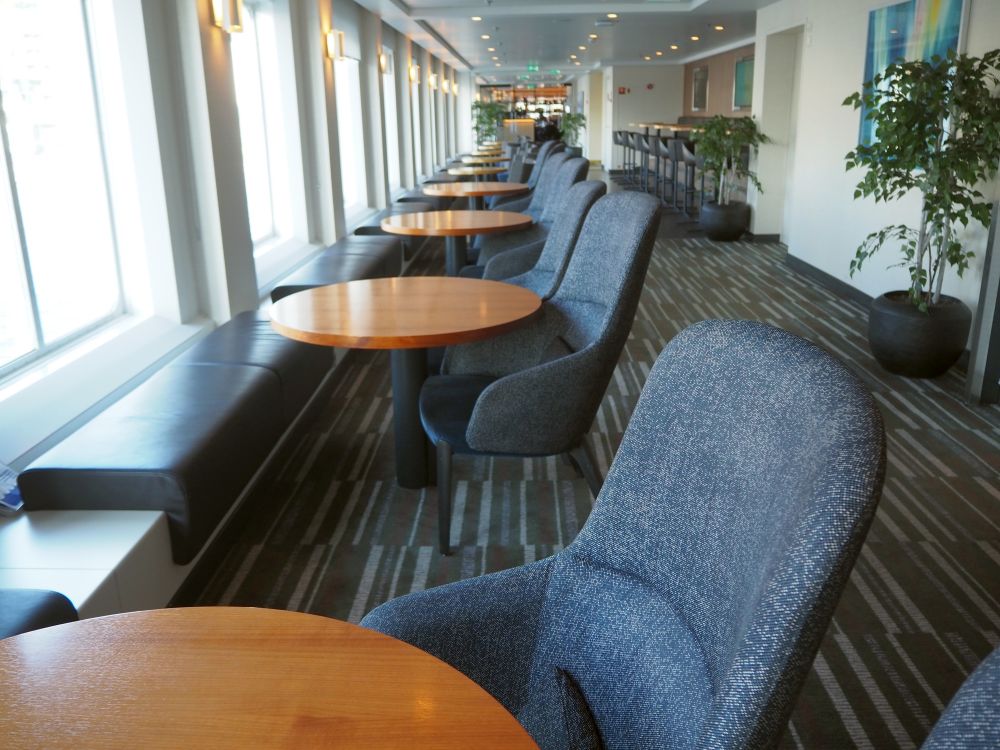
Level 5 has a walkway outside all the way around the ship, though most of the time the wind is pretty strong, so people tend not to stay there long. On Level 7 in the stern (rear) is a large open-air space with lounge chairs. Parts of it are relatively sheltered from the wind; other parts aren’t.
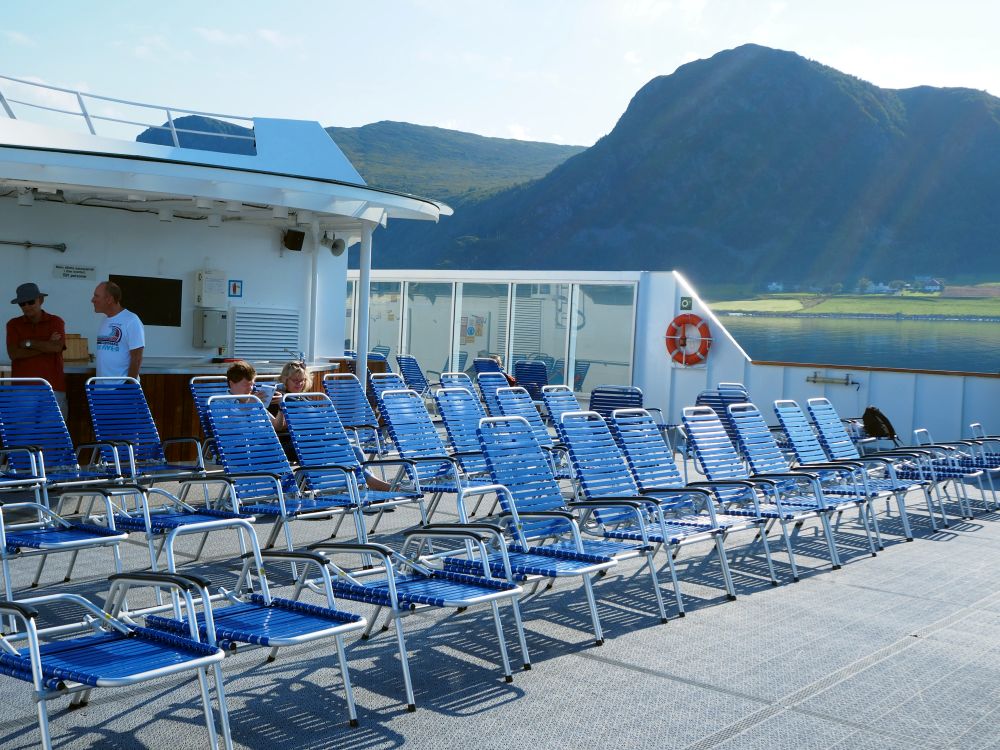
The Nordnorge has no theaters or stages or gambling. It does have a small gym with some equipment to work out on (on level 7, with a view), two hot tubs, and a sauna. And a small band in the bar in the evenings. That’s all it has in terms of entertainment. This is where it differs so strongly from traditional large cruise ships. Because it is a working ship, Hurtigruten does not take responsibility for its passengers’ amusement.
This is what we liked about it: the no-nonsense, no-fuss approach. We entertained ourselves quite well, what with the breathtaking scenery and the company of a good book.
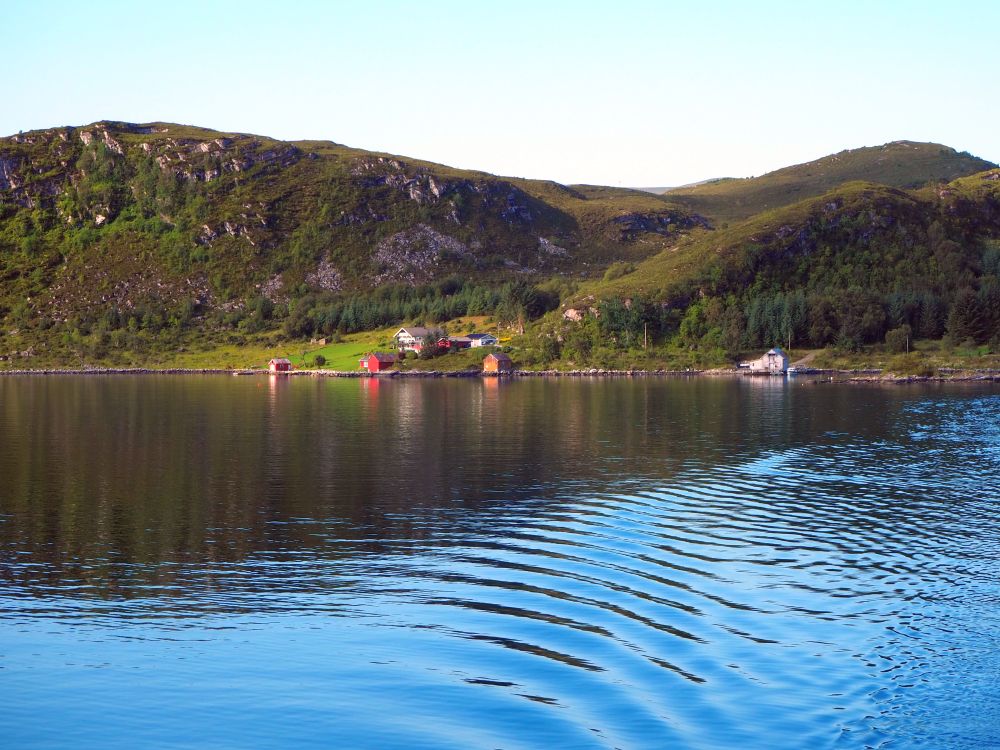
Every day we heard announcements on the ship’s loudspeakers in Norwegian, English and German. The announcements deal with things like where the next stop is, what the town’s population is, and other general facts about the place. Passengers are informed about informational meetings and so on. The announcements are not very audible in the room; we usually got up and opened the door to hear better.
Having said that the ship offers no entertainment, the boat does have an “expedition team”: young people who run informational sessions about Norway in general, its wildlife and geography, and about the places we passed in particular. These sessions generally do not go longer than about a half hour; they are straightforward, often amusing, and usually informative. Some of these sessions take place inside, in a conference room on Level 4. Others are held on the open deck on Level 7, allowing the expedition team staff to point out sights and give more information about them.
There was one session that could really be called purely entertainment rather than education, and it happened when we crossed the Arctic Circle. A crew member dressed up in a ridiculous costume to represent the god Njord. After making an over-the-top, overly dramatic (and hilarious) speech from the crew’s deck on level 8 to the crowd of passengers below on level 7, we were informed that we were expected to kneel to Njord and be baptized.
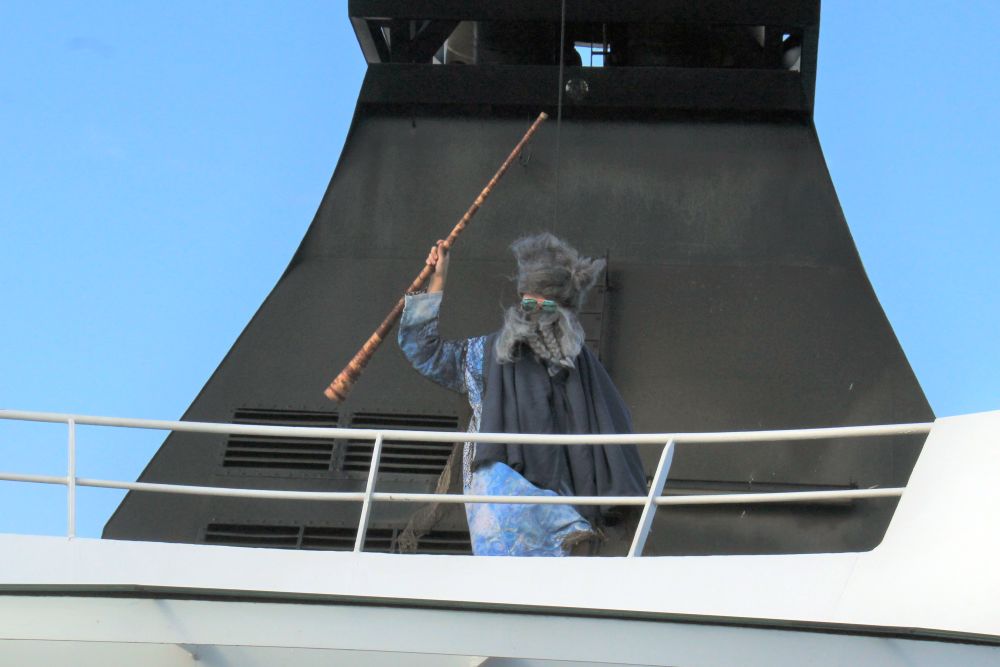
Which we obediently did, kneeling on a cushion and receiving a splash of ice water down our backs. There were squeals of laughter and we all looked like we’d peed our pants. We were compensated with a shot of some sort of sweet liqueur.
The other passengers were a mixed bag of mostly Norwegians, French, Germans and Americans. Some were part of larger tour groups and had a tour group leader with them; I was aware of one French group and one American group, but they did not overwhelm the atmosphere in any way.
Some passengers were quite elderly, while some were traveling in mixed-age family groups. Very few had smaller children with them: generally only locals who boarded for a shorter trip from one port to another. I was not aware of anyone who was loud or boisterous or disturbed anyone else. It was a generally very low-key group of people, which suited us just fine.
All of the staff, without exception, were friendly, professional and unobtrusive in carrying out their work.
Hurtigruten cabins
Our room was an “Arctic superior” cabin on the 5th level. It is quite small, with a full double bed that barely fits. We had to slide sideways between the foot of the bed and the wall to get to the window side of the bed. Even my husband, Albert, who is skinny as a rail, had to slide sideways.
On the other hand, the bed linen is high quality and the bed is high so there’s space under it for suitcases. We had plenty of cupboards and a closet for our clothing. I had a small desk where I could work and a kettle with tea and coffee makings.
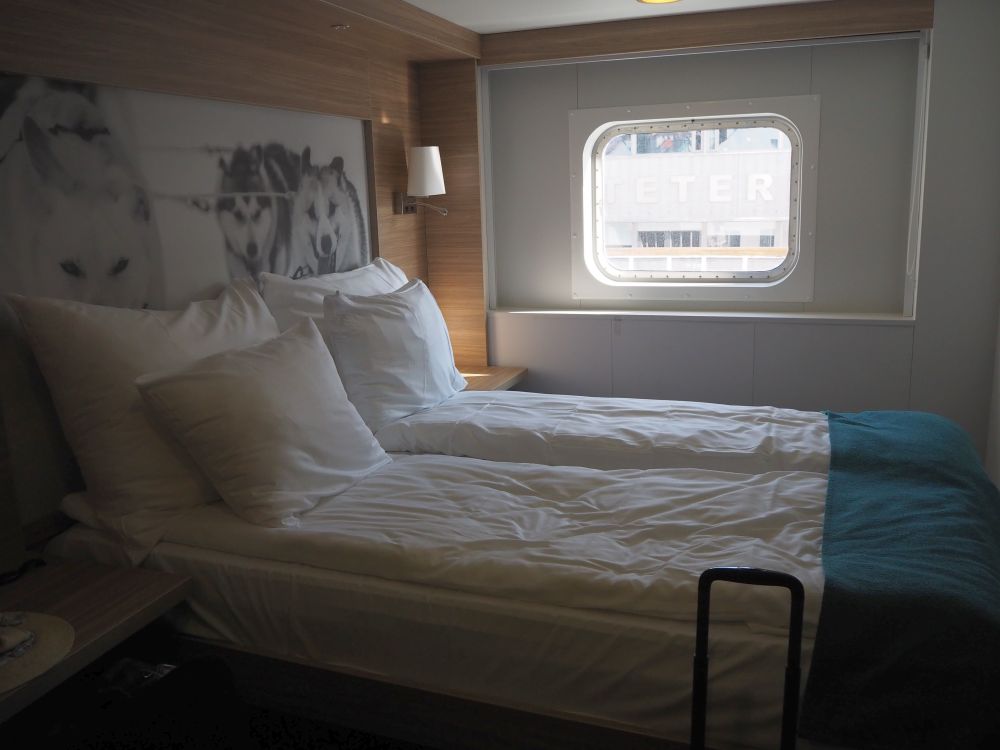
In our cabin, the window looked out on the 5th level walkway, which means people walked from time to time right by our window and could look in. We realized that during the day it didn’t matter; in the sunlight our window just reflected the glare. In the few hours of darkness, though, people could see in very easily, so we had to close the shade. I imagine that on cruises in the winter, this might get annoying, but for us it was no problem. The shade did quite a good job of blocking out the late and early sun when we wanted to sleep.
I was happy to find that the room has plenty of outlets: a double outlet on each side of the bed and another on a shelf in the cupboards.
The bathroom is tiny, so tiny that two people can’t both brush their teeth at the same time. The shower takes a triangular corner of the bathroom, but has excellent water pressure. Shelves on the wall provide a place for toiletries. The soap and “hair and body wash” and conditioner are Hurtigruten’s own house brand, “Arctic Pure”, provided in pump bottles.
The wall-mounted flat-screen TV has a channel that shows a live view from the bow of the ship. When we were in the cabin, we kept it on most of the time. It helped us deal with the pretty constant FOMO – fear of missing out – because we could see if we were nearing something worth seeing in person.
A different channel shows a map, with the boat’s location marked on it. The other channels are standard Norwegian stations, some of which show British or American shows.
It was all spotlessly clean and well-maintained, by the way.
The ship has other categories of rooms, both less expensive and more. At the high end are suites and “mini-suites,” both of which have two rooms on an upper floor.
Next are the Artic superior cabins like ours, which are on the higher floors. After that are a range of “polar inside” and “polar outside” cabins on lower, middle or higher floors. These all seem to be about the same size, but with two beds, sometimes three. The inner ones have no windows, while the outer ones have portholes or windows, depending on what level they are on.
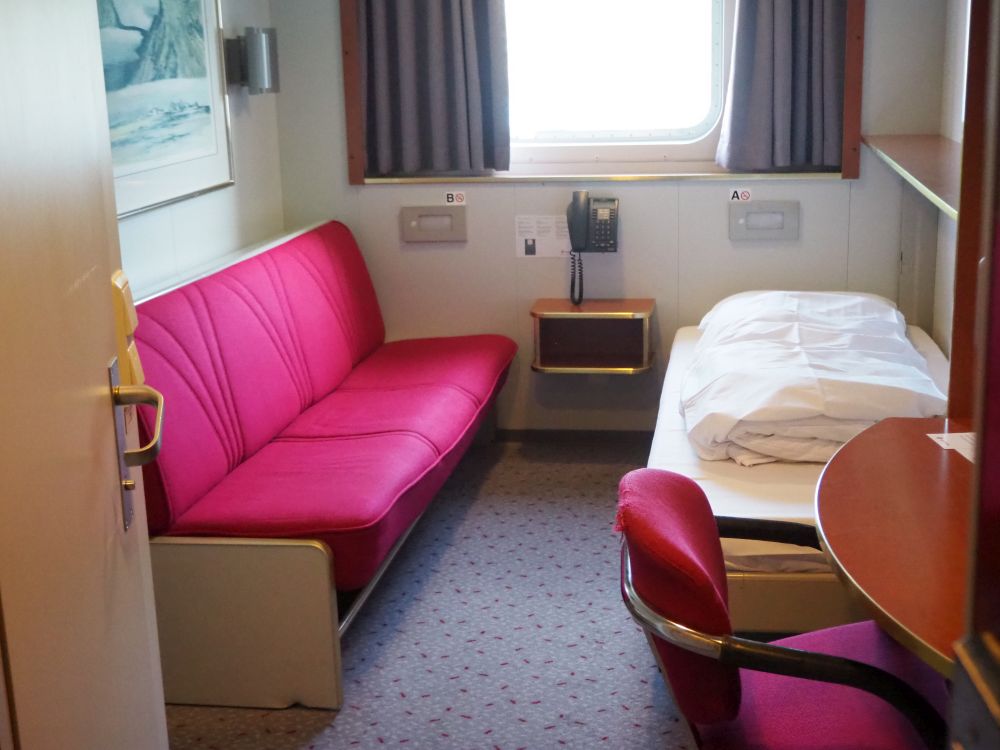
Besides our own room, I only got one brief glimpse into a “Polar” cabin on the 3 level as I was on my way out. Someone had left a door open. It was about the same size as ours with the same size window, but more simply decorated. It had, as far as I saw, just one single bed with a sofa opposite it, which, I assume, opens into a bed. In a way, this style is better than ours because it offers a place to sit. We had only the one desk chair and the bed to sit on.
While I can’t be sure, I think the 3rd level is probably also noisier; it’s closer to the engines below, it’s the level where people get on and off the boat, and it’s nearby where cargo is loaded and unloaded. On the other hand, in rough seas there’s less sway the further down in the boat you are, so it might be a good choice if you are prone to seasickness.
The ships do have a limited number of accessible rooms. Book early. There are elevators, and the floors do not have steps. You might have issues if you are wheelchair-bound at some stops, where the gangway may form a stairway, depending on the height of the pier.
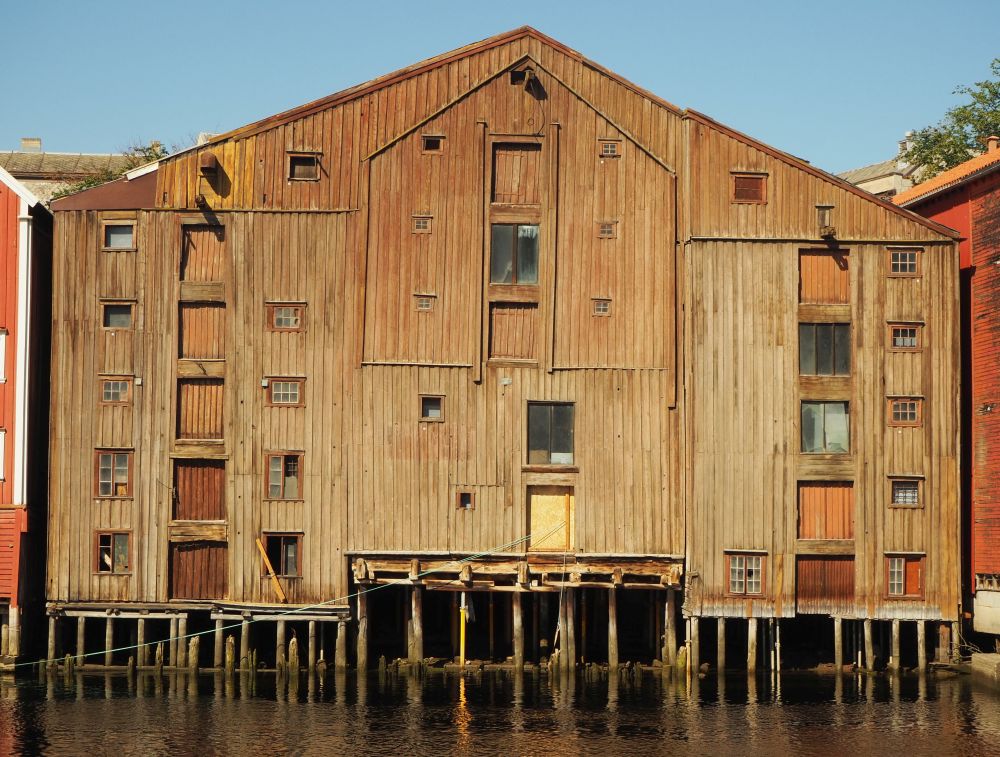
Meals on our Hurtigruten ship
We only ate at the main restaurant, since it was included in our fare. The other à la carte restaurants on board all cost extra, and we didn’t feel like spending more.
In any case, it wasn’t at all necessary. I was consistently impressed with the quality of the food on offer.
Breakfast is buffet-style, and includes a range of choices. We could choose from standard English breakfast items like eggs, sausage, blood sausage, beans, and so on. Eggs are available in fried, scrambled, soft or hard-boiled form. The breads generally have whole grains and/or seeds, and tasted fresh. We could choose from a range of things to put on bread: several cheeses, several sliced meats, and spreads of various sorts.
What the Norwegian breakfast especially excels in is fish: there was always salmon, usually smoked, and I loved the cold, smoked pepper haddock with a light mustard sauce.
Fruit is available every morning, both whole and cut-up, as well as a choice of yogurts and seeds, nuts, dried fruits and granolas.
They even have a selection of milks every morning: besides regular milk, there is oat milk, soy milk, lactose-reduced milk, and buttermilk. Guests can help themselves to orange or apple juice and, of course, tea and coffee.
Lunches are similar to breakfasts, but we could choose a cooked main course or just stick to bread-based foods to make sandwiches.
Dinners, though, are the real highlight. Most nights a set menu is served by waiters, and the quality rivals some of the best restaurants I’ve been to: interesting combinations of flavors, often including fresh fish, always interestingly arranged on the plate. Each evening includes a starter, a main and a dessert, consistently excellent, as was the service.
Hurtigruten tries as much as possible to source their ingredients locally, and that means wonderfully fresh-tasting food, particularly the fish dishes. A printed card at each table gives details of each dish, including where it comes from.
As an example, one night’s main was a remarkably flavorful Arctic char from Sigerfjord, served with baked beets, cabbage, potato with dill and a Hollandaise sauce.
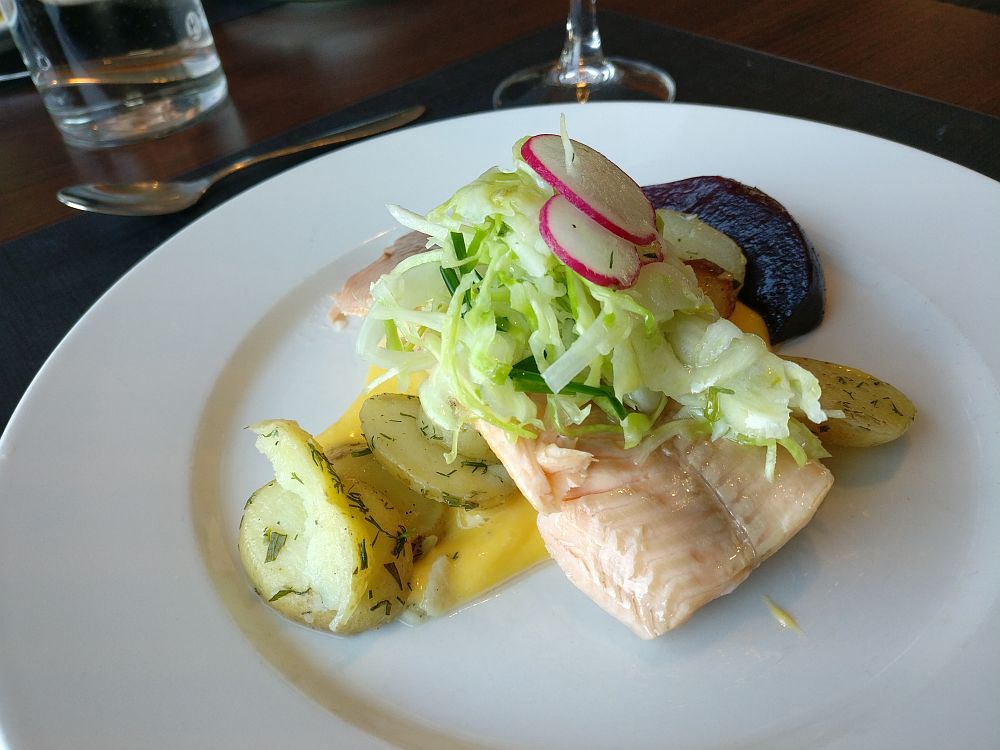
The menu card explained that the fish had been picked up during one of our stops during the night, and that root vegetables are a staple in Norwegian traditional cuisine.
Before the fish course, we ate a baked celery soup that was surprisingly tasty because of the small bits of Frans Josef sausage from Mydland in Tromsø.
After the fish course came our dessert: a chocolate terrine with blueberry compote and lemon thyme meringue. The menu card explained the superfood qualities of the Nordic blueberry.

By the way, vegetarian options are available for all meals, as well as gluten-free or fishless.
My only criticism has to do with drinks at lunch and dinner. No drinks are included, and even soft drinks like soda are extremely expensive, as they are all over Norway in restaurants. A wine menu offers a range of wines, also very expensive.
The prices matched what we’d seen on shore, so it wasn’t surprising. The ship does offer a wine package in which you can get a bottle of wine that pairs well with the set meal every evening. The problem was that we could not use the package only for selected evenings; the only options were to get a bottle every night or just order individual bottles or glasses more expensively, from the menu. However, if you order a single bottle of wine and don’t finish it, the staff will tag it and you can finish it the next night. That might be a better solution. We don’t drink that much, so it wasn’t worth it to us. I’d imagine that getting a wine package would make sense if you travel with a group of, say, four adults.
I would have liked to see a drinks package for non-alcoholic drinks, so that I could have had a soft drink or juice with lunch and dinner and perhaps between meals for the whole week. On the other hand, because we had an “Arctic Superior” room, we had a tea kettle we could use for between-meal cups of tea.
Environmental issues
It is good to see that Hurtigruten is paying attention to sustainability issues. The company has moved away from disposables in general; the only ones I saw were paper goods like napkins, tea bags and things like sugar packets. The company has also begun to convert its fleet to hybrids, which will reduce fuel consumption and carbon emissions significantly.
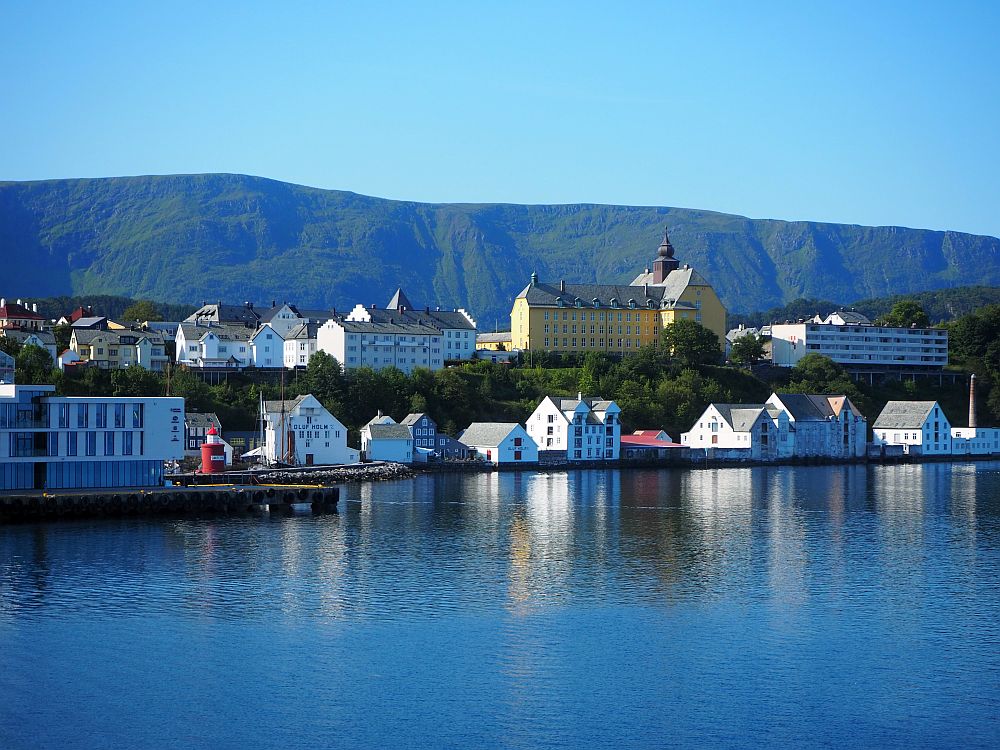
Public spaces on Hurtigruten ships
Hurtigruten ships vary in terms of layout. This particular ship doesn’t have a huge amount of outside space, and I suspect none of them does. As I mentioned above, we could walk entirely around the 5th level outside, and go outside at the stern of the ship on the 6th and 7th levels too. The 6th level is where the two hot tubs are (outside), but only on a little piece of deck outside in the stern of the ship. On the 7th level is a larger deck with lounge chairs and a separate smoking section on the starboard (right) side.
It’s not surprising that very little space is available outdoors: normally, the weather and wind almost every day of the year wouldn’t allow you to really relax outdoors. Our trip happened to be unusual: a heat wave was broiling all of Europe at the time, and for the first four days of our trip the temperature reached over 30°C. We spent a lot of time outdoors, but that is the exception to the rule, I think. Be warned: even in the summer it can be chilly so far north!
Inside, there’s plenty of room to move around and look at the scenery. Level 7 has lots of big views available from inside. The same goes for one side of level 4.
Amazing scenery
The main reason to take this trip is the amazing scenery: the ever-changing views of mountain and sea, the sunsets that go on for hours, if you travel in the summer as we did, or the northern lights, which you might get to see if you travel in winter. I found it hard to do anything else but take pictures: lots of pictures. It was all just breathtakingly beautiful.
The best parts of the trip, if I have to choose, were the two fjords we traveled down. The first, and most well-known, is Geirangerfjord. This long fjord is famous for its dramatically steep sides and bridalveil waterfalls. I know I keep using this word, but it was truly breathtaking.
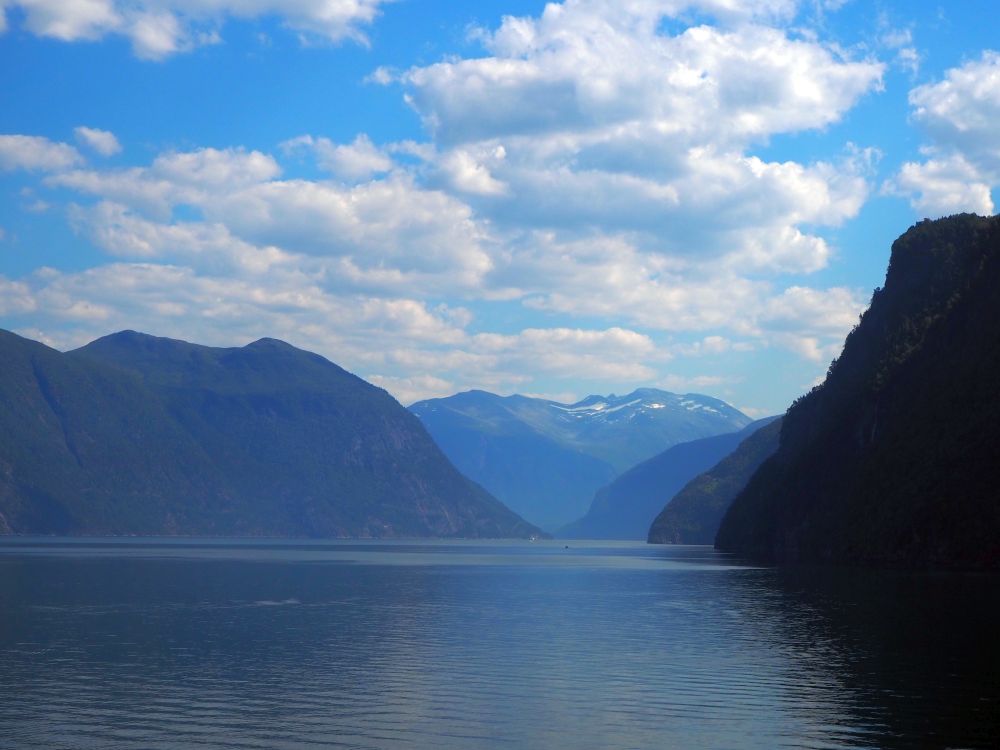
While even the huge cruise ships go into Geirangerfjord, the special side trip from our Hurtigruten cruise was much further north, going into Trollfjord. Only smaller ships can do this and only in the summers, and when the weather allows. Trollfjord is narrow: about 100 meters wide at its mouth and about two kilometers in length. The sides are steep and sheer and it is a real feat of seamanship how the captain is able to turn the ship around to exit the fjord safely.
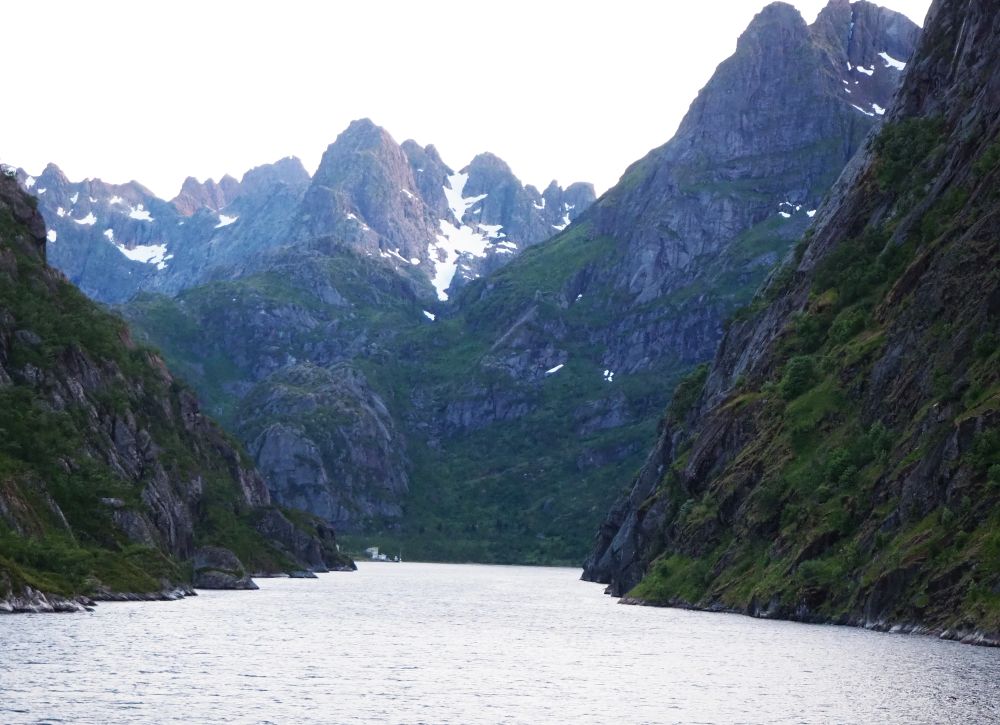
Even just cruising along between stops, usually with the mainland on one side and islands on the other, we saw one beautiful view after another. The landscape was mountainous and green during the first part of the trip, and the late light meant that the photographer’s “golden hour” actually lasted several hours. Small farms and homes huddle picturesquely into the hills.
In the second half of the trip the landscape turns starker: fewer trees, more rock and low shrubbery on craggy mountains. Each port is different, and I enjoyed taking pictures of the fishing boats and boathouses we passed.
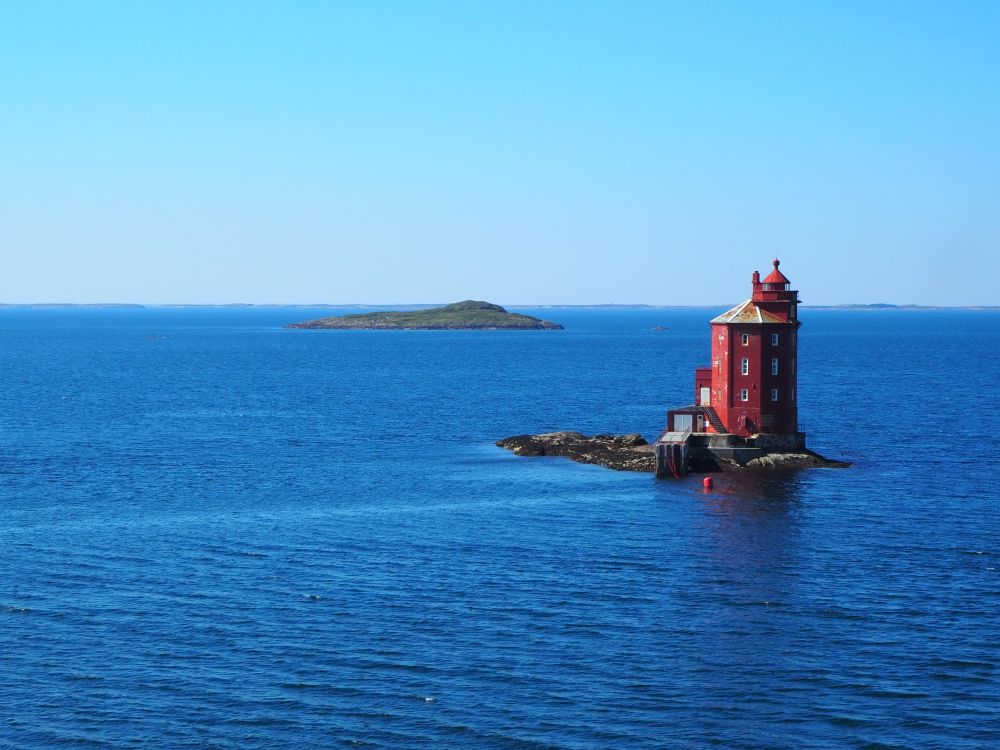
The last full day of our trip, the weather turned gray and abruptly cooler. This meant the views were a bit less awe-inspiring without the blue skies, but I still found myself bundling up for forays outside to take more pictures.
I should point out that we were extraordinarily lucky with the conditions of our cruise. That week, the sea was very calm, the weather was clear and warm, and only on our very last day did we feel any real motion in the ship. In other words, as they say, “Your mileage may vary.”
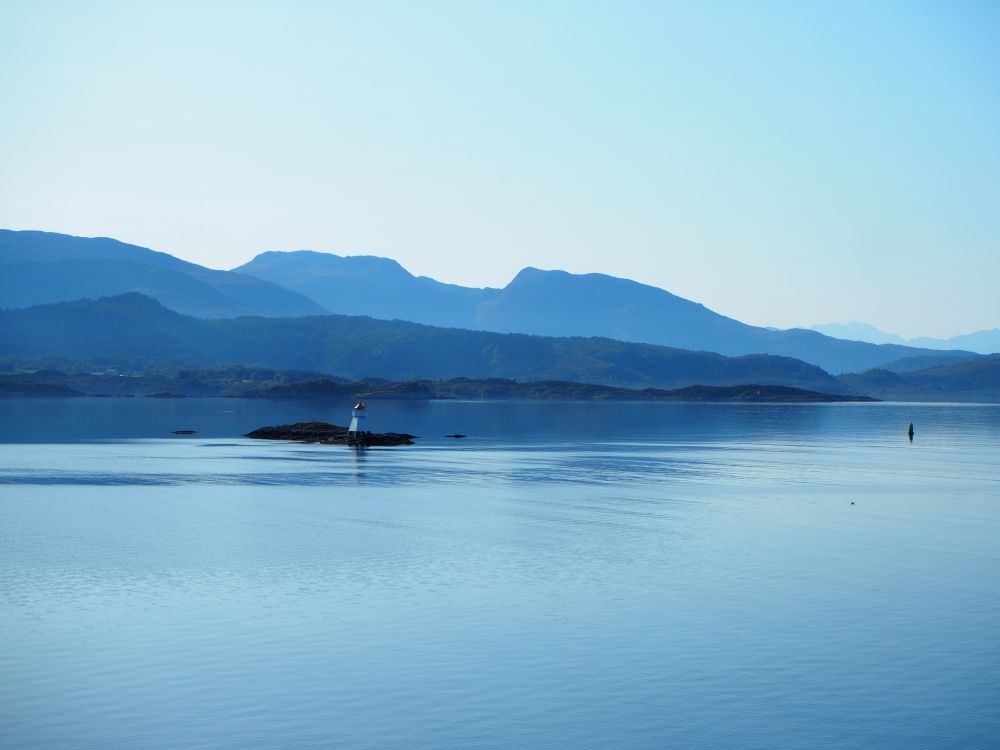
If you choose to take a winter cruise, you’ll spend more time inside, I suppose, popping outside to take pictures. You’ll have only a short period of full daylight each day for photographing the scenery, but I’m told that the rest of the daytime there’s a sort of half-light, like twilight. Apparently, the snow-covered landscape is absolutely stunning.
Hurtigruten routes and ports
The regular trip up the Norwegian coast (the “Coastal Express – North”) that we took stops at 34 ports. That doesn’t mean that passengers can explore them all, since most of the stops only take about 15 minutes: just enough time to offload and load cargo.
These shorter stops happen during the night as well; generally between one and three stops each night (i.e. after about 22:00 and before 6:00). If you’re a light sleeper, as I am, this could be a problem. As the ship nears the port, slows or turns, the engine’s sound and feel change. Where normally it is almost imperceptible (at least in our room on the 5th level), it takes on a lower tone and vibrates noticeably more than when it’s moving at full speed. Sometimes this change of “feel” woke me up.

A few of the stops are longer, and happen during the daytime. I can tell a bit here about our stops on the way north, but the longer stops on the way south (the “Coastal Express – South”) are different: then they stop at Hammerfest, Svolvær, Brønnøysund and Trondheim. To get the full experience, you’d really have to take the 12-day roundtrip.
Bergen
Bergen is the starting point of the northward voyage. The main draw in Bergen is Bryggen, the area of historical warehouses built by the German “Hanseats” who came here to take part in the trade in fish. A UNESCO World Heritage site, the area was crawling with tourists when we were there, enjoying the sun at the outdoor cafes on the quayside in front of the buildings. If you go, make sure to explore the alleyways between and among the warehouses, and to visit the museum that explains the history of the Germans who made this their temporary home.
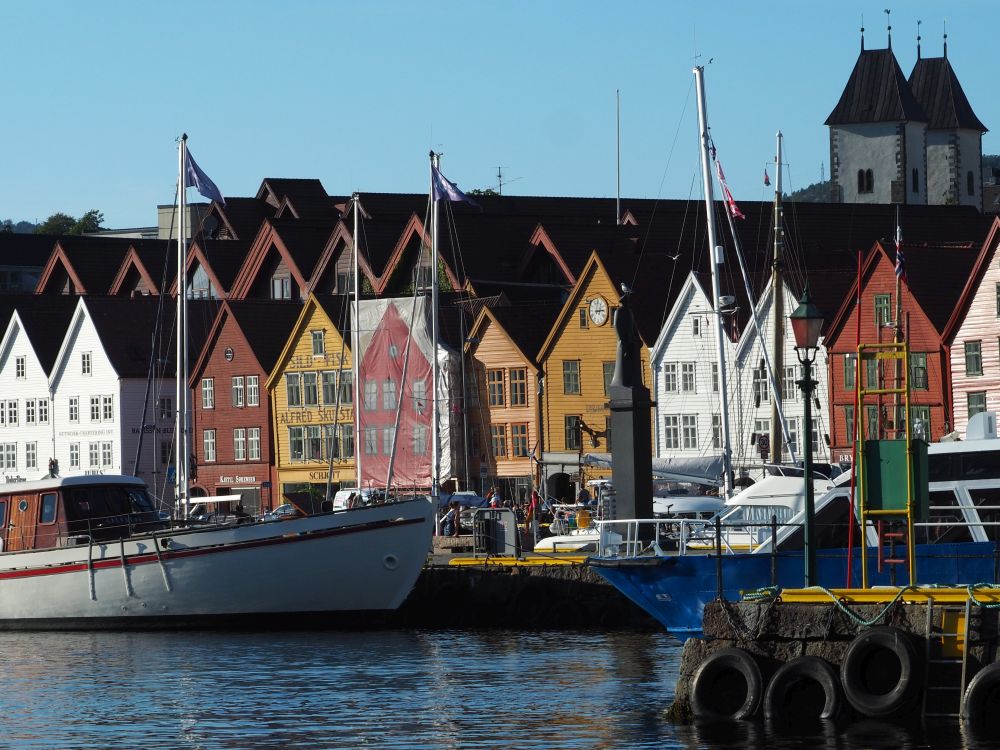
Take this two-hour walking tour to learn about the history of Bryggen.
Another popular attraction in Bergen is the hill above the city, called Mount Fløyen, about 320 meters above sea level. You can take a funicular up and/or down. You can also hike up, which should take about 45 minutes. From the top, the view is spectacular if the weather is good.
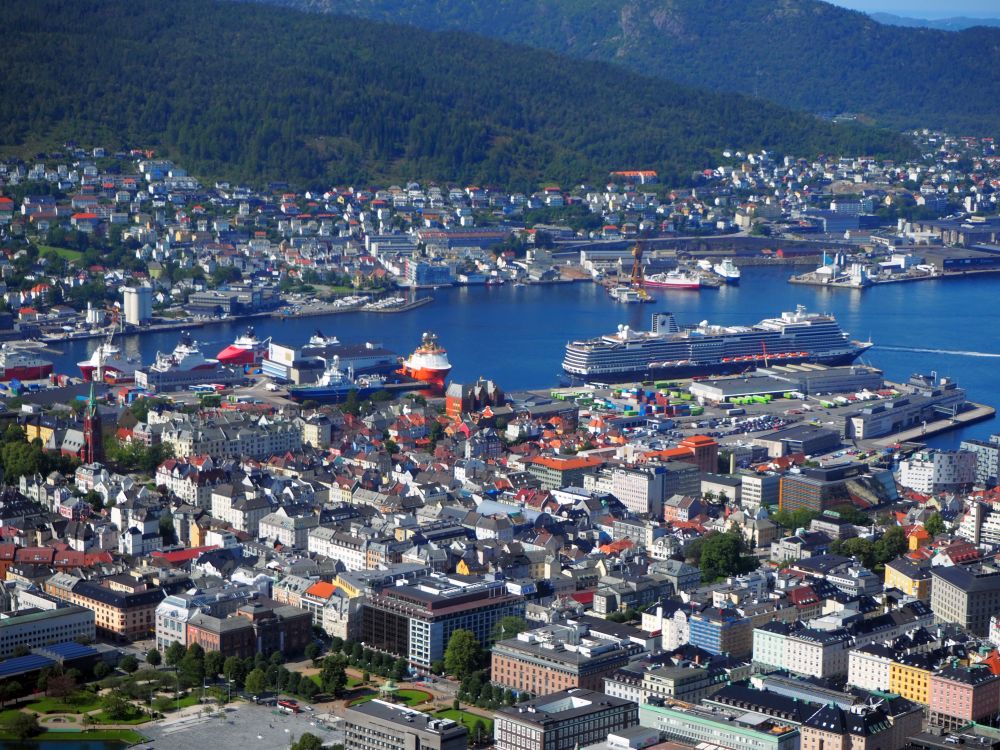
Here are lots of things to do in Bergen.
Check out your options for accommodations in Bergen here.
Trondheim
Trondheim is the only longer stop that the ship makes in both directions. It has a very pretty center for a stroll around, which we were able to do well in the three hours that the boat was docked in port. Their medieval cathedral is astonishingly complete. A river divides the town, lined with old warehouses painted in bright colors. Charming shops and a fortress on a hill overlooking the town complete the picture. Check out the bicycle cable track meant to help bicyclists up the hill toward the fortress.
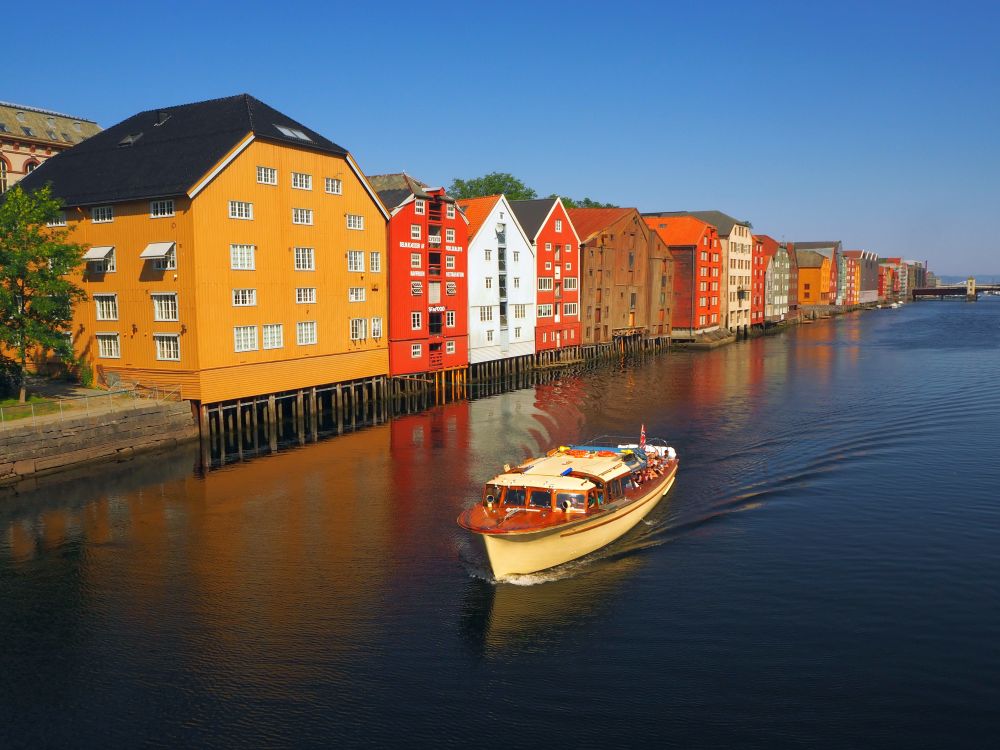
Bodø
Our stop in Bodø was short, only about two hours, which didn’t leave time to see some interesting sights further out of town (a reason to sign up for excursions). Limited to the town itself, we should have visited the Nordland Museum, a history museum, but instead went to the Salmon Center at the port. There we learned from a very enthusiastic young woman – I got the feeling they don’t get many visitors – all about how salmon farming works, how the fish are moved to cages in the ocean, how they are transported back and forth, why there are differences in coloring among salmon, and generally far more than I ever needed to know about salmon.
Tromsø
Within the Arctic Circle, Tromsø has a very interesting Polar Museum, covering the various expeditions to the North Pole that set out from this city in earlier centuries. With most displays in both English and Norwegian, it does a good job covering life in the far north – especially involving hunting – and the general craziness of some of the expeditions.
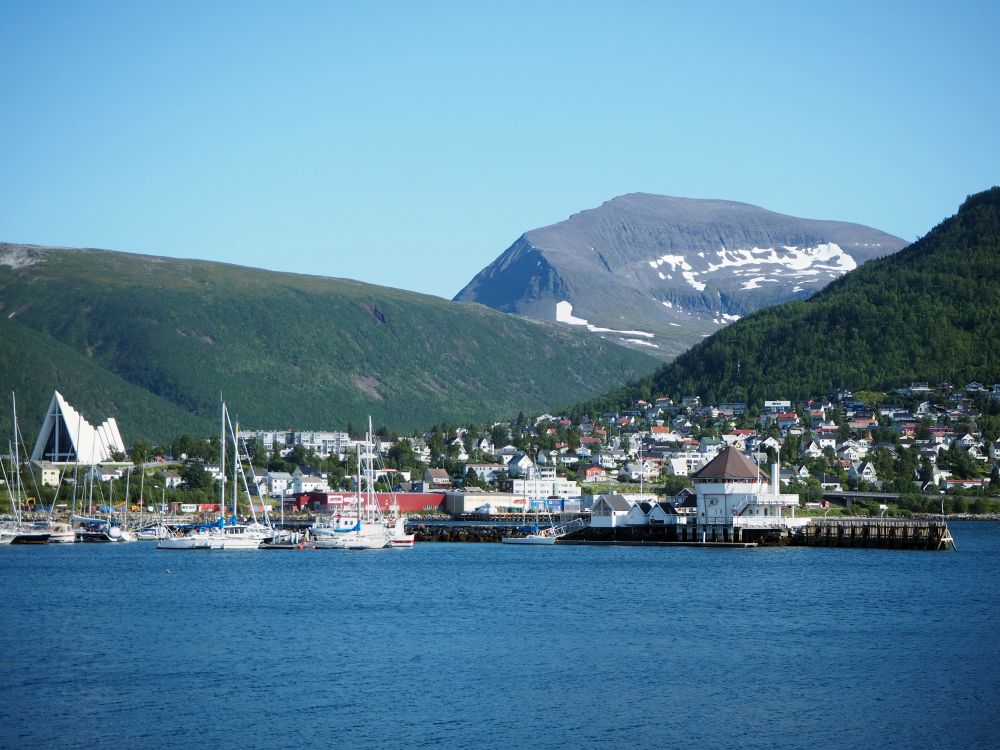
Tromsø’s main shopping street, lined with wooden buildings that reminded me of some small towns in northern California, is pleasant to stroll. Look out for two charming wooden churches: one Catholic and one Protestant.
Many visitors spend this stop taking a cable car up to the top of the mountain overlooking the town, which offers magnificent views.
In Tromsø, take this short whisky distillery tour or this private city tour.
If you want an amusing drink with your traveling companions, try Magic Ice, right next to the dock, where you can sit at an ice table, drink from an ice glass, and admire ice sculpture all at the same time.
To read lots more about Tromsø, with lots of practical advice, read How to travel to Tromso on a budget without missing the fun.
Honningsvåg
There’s not much to see in Honningsvåg, though it is a jumping-off point for excursions of various sorts, mostly to the North Cape. Since I hadn’t signed up for one, I visited the Nordkapp (North Cape) museum, a rather underwhelming exhibition about local history. I liked my stroll along the port, trying to picture what it must be like living through the dark winter that far north.
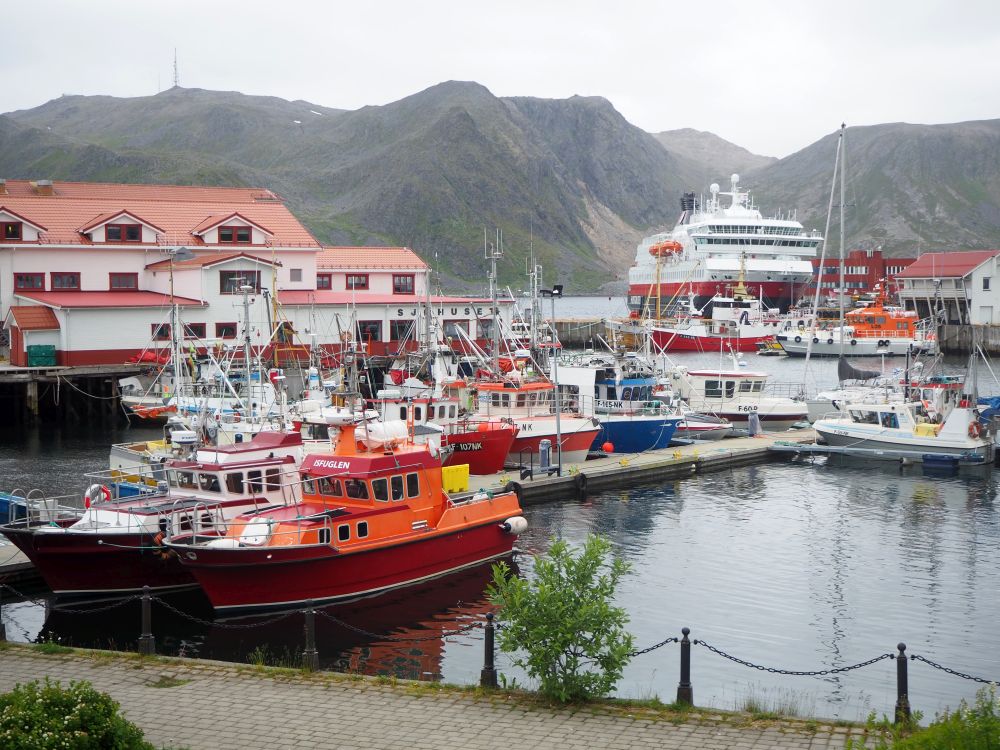
Hurtigruten excursions
I didn’t sign up for any excursions, while my husband went on two. In the course of the northward voyage, about 130 assorted excursions are offered, though not all of them run all year. It wouldn’t make much sense, for example, to offer a dog-sledding experience when there’s no snow on the ground.
The excursions range from short city walking tours to all-day expeditions. The longer ones involve getting off the ship at one port and boarding again at another port; all transportation is provided for, of course.
The difficulty level of the excursions varies as well. Each is rated on level 1 to level 4, with level 1 involving little physical activity and 4 requiring a high level of fitness.
The excursions don’t come cheap. The least expensive (US$81) is a 1.5-hour Art Nouveau walking tour in Ålesund (spring and fall only). The most expensive (US$458) is a 2.5-hour snowmobiling trip from Kjøllefjord to Mehamn (winter and spring only). The rest range between those two extremes.
Hurtigruten excursions review
I can’t vouch for any of the excursions other than the two my husband took, but I assume they are indicative. His first excursion was to Geirangerfjord.
Geirangerfjord
The advantage of this excursion – and the reason my husband signed up for it – is that the participants get to see the fjord two ways: once from the ship as we cruise the length of the fjord, and then again from above.
First, the group was transferred by tender boat to the shore and put on a bus. In this case, there were three buses, one for English speakers, one for German speakers and one for French speakers.
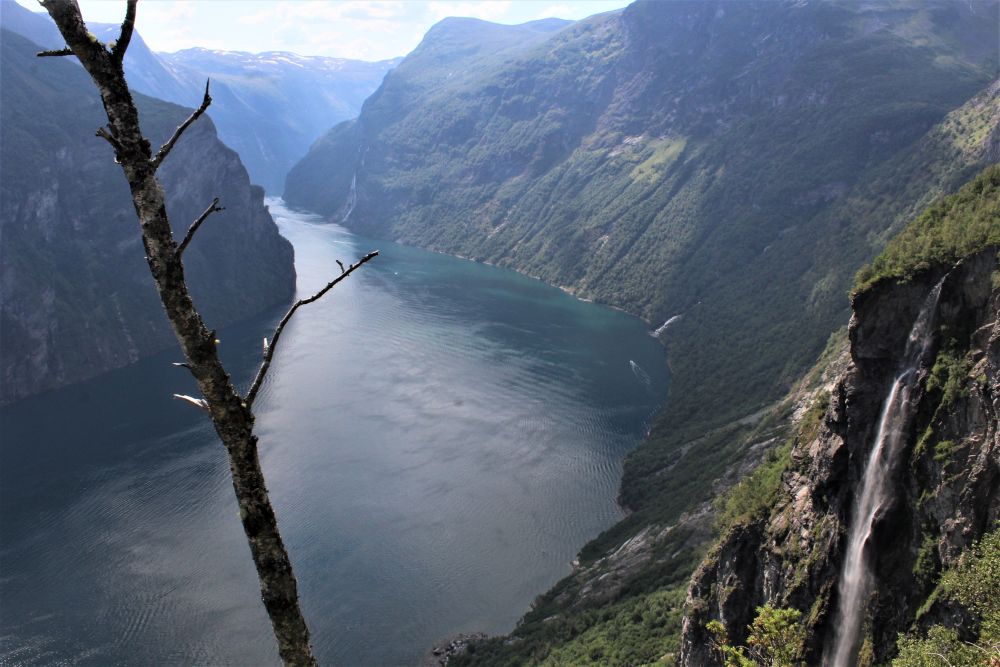
Their first stop was up high to get a magnificent view onto the fjord. They got off the bus in a flat place, but a path led up the mountain. Some of the participants, including my husband, headed up that path for an unobstructed view. It turned out he didn’t have enough time to climb as high as he wanted to. He realized the time and ended up sprinting back down the path to get to the bus. He was not the only one who felt that this stop wasn’t long enough.
On the other hand, other stops were longer than they needed to be. When they had lunch, for example, they ended up with extra time to wander, not really doing anything. Of course, this can be a problem with any group excursion: differences in how much time each person needs at each stop.
It was worth it, my husband told me, because the scenery was absolutely amazing. “One waterfall was more beautiful than the next. I didn’t know where to look it was all so pretty.”
The excursion was well organized and ran smoothly, and the staff kept count of the guests at each stop. Because they missed lunch and dinner on the boat, these meals were included in the excursion.
Birdwatching excursion
The second trip he took was a birdwatching tour from Honningsvåg. Debarking on the quay, the participants – fewer this time, about 15-20 people – took a bus for about 40 minutes while the tour leader gave information in French, German and English. They spotted some reindeer on the way.
Arriving at a fishing village, they boarded a small boat, but it was big enough so that they could choose to sit inside or outside and move between the two. The boat took them to an island for birdwatching. They did not get off the boat, but could see plenty of the island’s birds from the boat: a whole colony of northern gannets, many seagulls, hundreds of puffins (swimming and flying), sea eagles and lots of cormorants. Binoculars and extra jackets were provided for those who needed them.
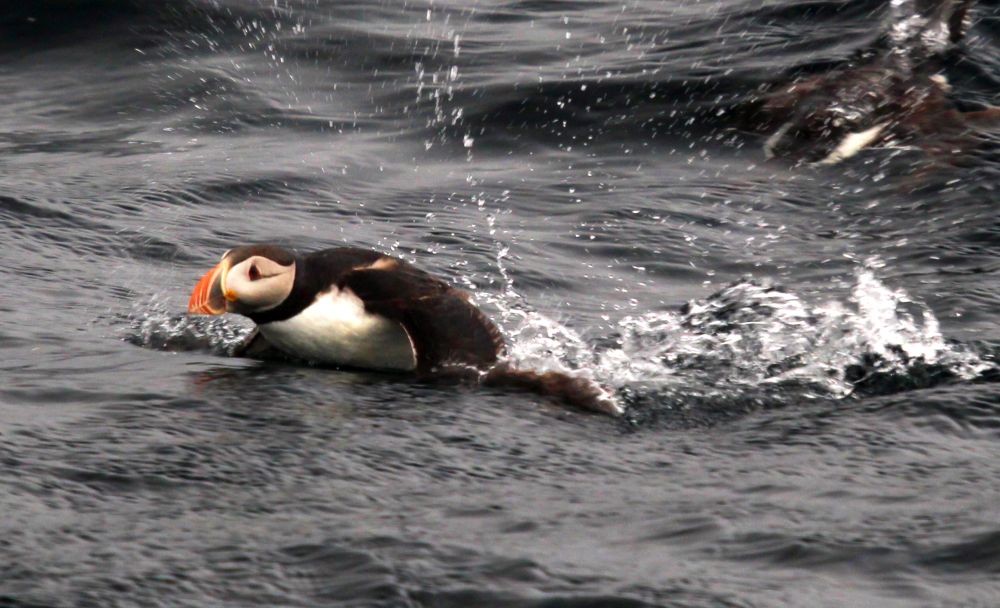
While Albert thought both of the excursions he took were steeply priced, he was still happy he did them because, he felt, he wouldn’t have seen these things otherwise.
If you want to read more about the excursions, the person who wrote this Cruisecritic report on a trip on the MS Nordnorge took lots of the excursions and was very enthusiastic about them all.
To me, it seems a good thing that they offer several possible excursions in each place so people only take tours they’re really interested in. The people on the birdwatching tour were really interested in birdwatching. I would have hated it, since city and culture tours are more my style.
Some passengers on our ship chose a competing tour at Honningsvåg, where the thing to see is the North Cape. They booked a local tour company which cost half as much as the equivalent excursion organized through Hurtigruten. This worked out well, but involves a risk. These local companies will do their best to get you back to the port in time for the ship’s departure, but will not guarantee it. You could do a similar excursion in other longer stops as well, particularly Tromsø.
In our effort to avoid the expense of too many excursions, I downloaded a couple of audio walking tours on the VoiceMap app: one for Trondheim and one for Kirkenes. Both were quite short at a half hour or so, but gave us some of the background we needed to understand what we were seeing. With a bit of planning ahead, you could probably find similar tours, either written on blogs or in audio form.
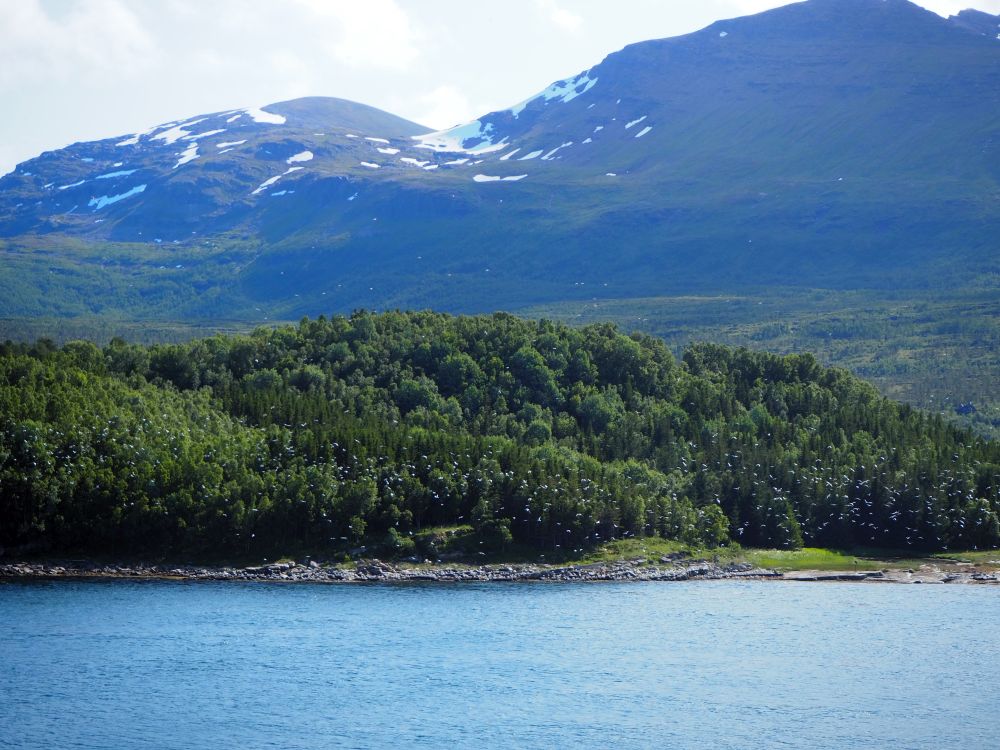
Advice for your Hurtigruten voyage
- Don’t take a Hurtigruten cruise if you want entertainment or activities. There are regular cruise lines that go up the Norwegian coast; take one of those.
- If you want a shorter trip, just travel between Bergen and Tromsø, which would make a 4-night cruise. That way you see the best parts of the trip: the Geirangerfjord, Trondheim and the Lofoten Peninsula, and, if it’s summertime and the weather cooperates, you’ll get to see the Trollfjord too.
- Another possibility would be to take a Hurtigruten boat north from Bergen to Trondheim or Tromsø. Get off in Trondheim or Tromsø for one or more nights to do some sightseeing or hiking or any of the many other activities you can do from there, then get on a southbound Hurtigruten boat.
- We brought our car on the trip so that we could drive back down through Finland and the east coast of Sweden. It meant a lot of driving, and I certainly wouldn’t want to do it in the winter. What many people do instead is fly in one direction or the other. You can get flights on SAS, Wizzair, Widerøe, Norwegian and Finnair to or from Tromsø. Widerøe, SAS and Norwegian also fly to and from Kirkenes. Alternatively, take the full round-trip cruise.
- If you want to see a bit of Russia, you can cross into Murmansk from Kirkenes. Depending on your nationality, you may need to arrange a Russian visa ahead of time.
If you’re considering driving in one direction or the other, read these posts about places we saw on the way back down:
What to bring
- Things to do: books, games, whatever can keep you occupied for hours on end. Especially if you travel in the wintertime, you’ll have little to do during the darker parts of the daytime and even at night if it’s cloudy.
- Lots of layers. The temperature can vary by the hour and depending on where you stand on the outside decks. This includes hat, gloves, scarves, etc. And, of course, if you’re traveling in winter, bring very warm clothes, including multiple layers of fleece and/or wool if you expect to spend any time out on deck (Northern Lights when the sky is clear!) or take any excursions.
- Good shoes. For our trip, our everyday shoes or sandals were fine, but if you go in the fall, winter or spring, you’re likely to need better shoes. Bring the kind that are higher to support your ankles and that have good gripping soles. Make sure they’re waterproof and comfortable to wear with warm wool or synthetic socks.
- Binoculars.
- A camera with an extra large capacity SD card.
- If you’re traveling under the midnight sun, you might want to bring an eye mask. The shades are good in the rooms, but light leaks around the edges a bit.
- Sunscreen in the summer, spring and fall.
- If you are prone to seasickness, bring seasickness pills. Even if you don’t generally get seasick, it might be worthwhile bringing some, just in case. The open-sea portions of the trip can get quite rough.
- If you are traveling with children, bring plenty of ways to keep them entertained.
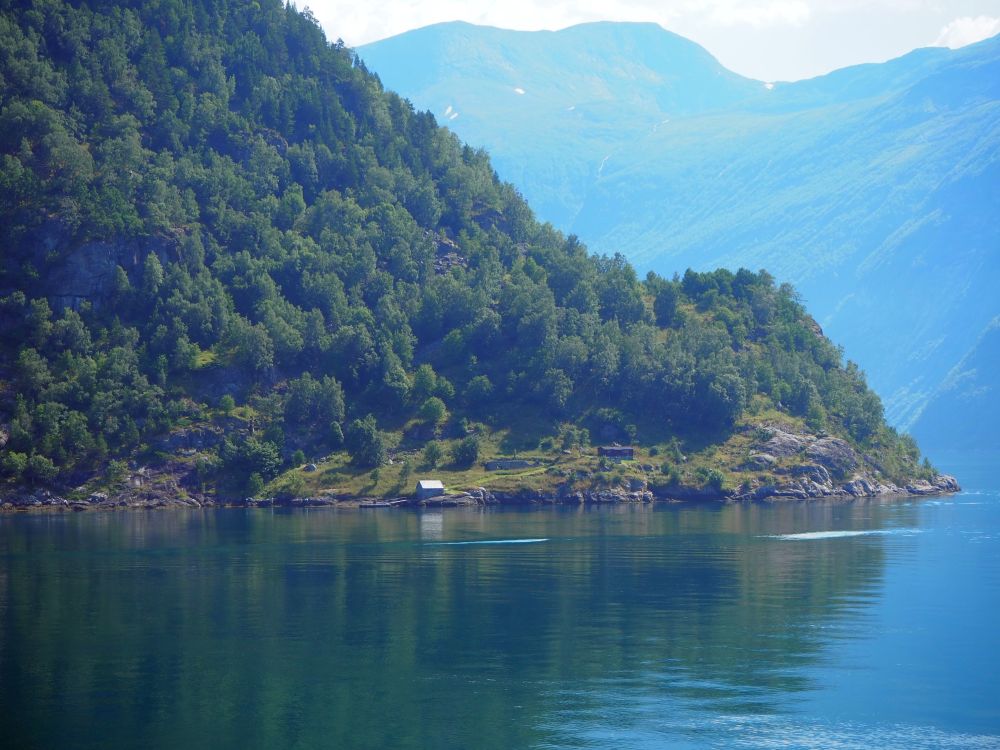
Advice for while you are on the Hurtigruten ship
- Speaking of seasickness, when you first board the boat, go to the table next to the reception where informational sheets are available. One of them tells exactly when each open-sea portion of the trip is, so you can take your seasickness pills a couple of hours beforehand.
- Don’t feel you have to spend money on drinks every day. Juice, milk, tea and coffee are provided at breakfast, tea and coffee at lunch, and water is always available. The tap water in the rooms is drinkable, and, if you have an Arctic Superior room, you can make your own tea or coffee.
- Alcoholic drinks are expensive. If you are likely to go through a bottle of wine every dinner, then the wine package might be worthwhile.
- The standard meals are excellent. There’s really no reason to spend extra on the more upscale à la carte restaurant or the “bistro.”
- If your trip involves more travel beyond the Hurtigruten cruise, take advantage of the opportunity to do laundry. They charge the equivalent of about 3 euros for a token for one wash, which includes detergent and a free dryer.
- If you have any dietary restrictions, make sure to make it known when you reserve and again when you board the ship.
- Go to the daily lectures. They are interesting, often include useful information, and can be entertaining at times too.
- Even if you don’t sign up for any excursions, get out in Trondheim and Tromsø: both are worth exploring a bit.
- If you buy a postcard on the ship, you can also buy special Hurtigruten stamps at the reception. Once you cross the Arctic Circle, you can get the cards postmarked specially to show they’ve been sent from there. Opposite the reception desk is a mailbox which gets emptied regularly … it is a mail boat, after all!
- The included wifi is pretty good but varies: at times the connection was excellent, but at other times it was quite slow.
- Turn off your data roaming, or you might get a big surprise on your next bill. Even if you have a European sim card that covers Norway, it’s a good idea to turn off data roaming. Parts of this voyage are far from shore, and you might end up getting switched to a maritime data network. I turned my roaming back on when we were in a port, but otherwise used the ship’s wifi.
- Tipping is optional: neither required nor expected. If you want to give a tip, ask for an envelope at reception or the entrance to the restaurant and leave it in the tip jar. All tips are split among the staff.
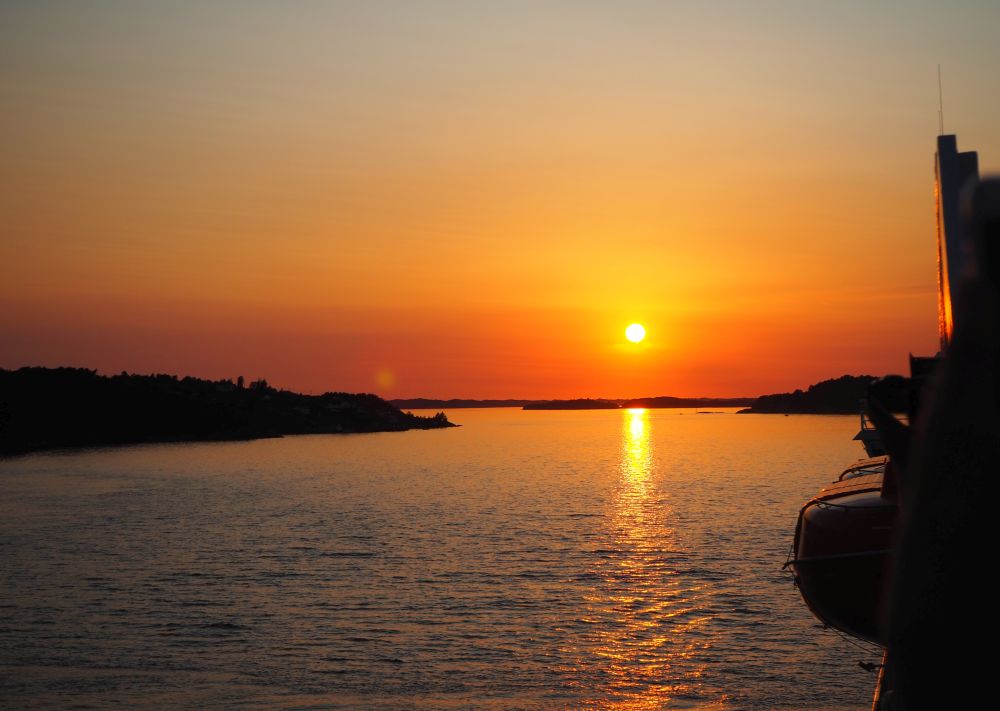
Hurtigruten prices
The Hurtigruten cruises – or really any cruises – are not for those on a very tight budget. They cost a lot, and end up more if you buy drinks. The excursions are expensive but good quality; you pay a premium for the reassurance that you’ll get back to the boat as planned. On the other hand, the price includes good, clean, well-thought-out accommodations and all meals, plus some absolutely breathtaking scenery on a daily basis.
The prices are dynamic, like airlines use, so it is difficult to quote a price with any accuracy. They also vary per ship, per cabin and per season (It’s more expensive in summer than winter). You can check their website here.
A pricing tip: southbound can often be cheaper than northbound.
Keep in mind, though, that the prices are all-inclusive, unless you drink alcohol. Norway is a very expensive country on land as well. Your $1,650 per person for a six-night trip means $275 per person per night for accommodations and all meals: not a bad deal at all in Norway.
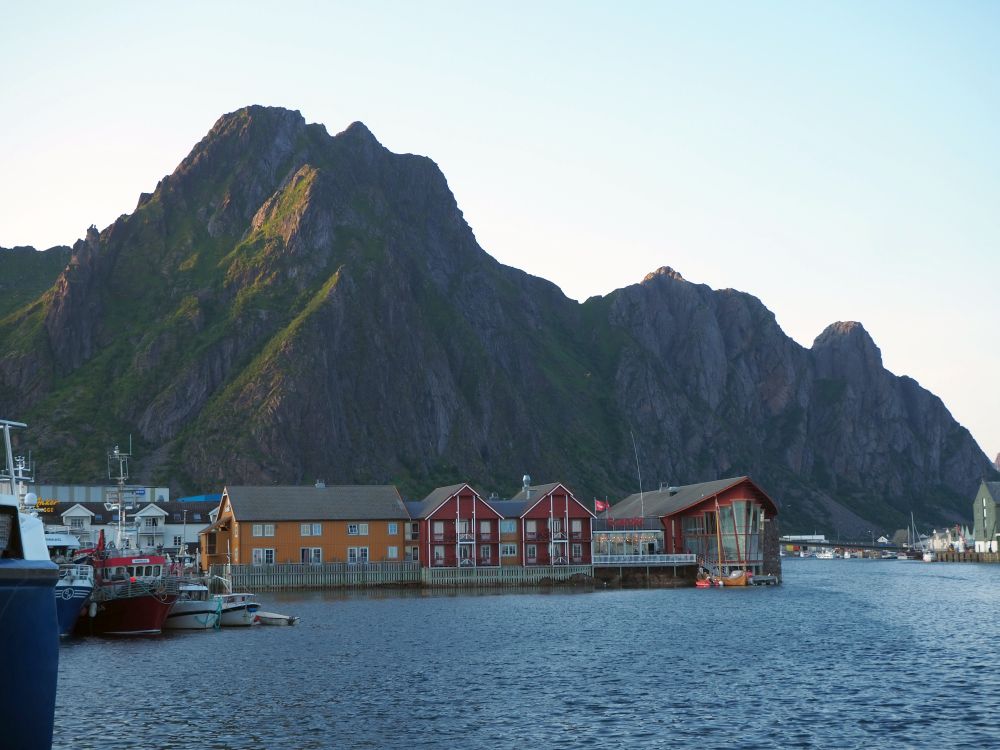
Advice for booking a Hurtigruten cruise
- To book a Hurtigruten cruise, first choose where you want to go. We did the northward trip up the coast of Norway, but there are other itineraries that include stops in Oslo, Helsinki or other ports in Finland, or Svalbard. How much time do you want to spend on the ship? How will you get to your starting point? What’s your tolerance level for bad weather and cold?
- Book far ahead of time for the best selection and prices.
- If you are traveling with children, choose a ship carefully. Look at what excursions are available and whether they seem child-friendly. If you’re traveling with younger children or teenagers, will they be able to keep themselves occupied on the trip you’re considering?
- Think about what amenities you need or want. Is a window necessary? How about a double bed? Do you need a hot tub or sauna?
- Do you want to take a car along? Not all of the ships take cars.
Book your Hurtigruten cruise here. I highly recommend it!
Is a Hurtigruten cruise something you’d enjoy? If so, would you prefer to travel in the summer or winter? Or would you prefer a more traditional cruise line?
My travel recommendations
Planning travel
- Skyscanner is where I always start my flight searches.
- Booking.com is the company I use most for finding accommodations. If you prefer, Expedia offers more or less the same.
- Discover Cars offers an easy way to compare prices from all of the major car-rental companies in one place.
- Use Viator or GetYourGuide to find walking tours, day tours, airport pickups, city cards, tickets and whatever else you need at your destination.
- Bookmundi is great when you’re looking for a longer tour of a few days to a few weeks, private or with a group, pretty much anywhere in the world. Lots of different tour companies list their tours here, so you can comparison shop.
- GetTransfer is the place to book your airport-to-hotel transfers (and vice-versa). It’s so reassuring to have this all set up and paid for ahead of time, rather than having to make decisions after a long, tiring flight!
- Buy a GoCity Pass when you’re planning to do a lot of sightseeing on a city trip. It can save you a lot on admissions to museums and other attractions in big cities like New York and Amsterdam.
- Ferryhopper is a convenient way to book ferries ahead of time. They cover ferry bookings in 33 different countries at last count.
Other travel-related items
- It’s really awkward to have to rely on WIFI when you travel overseas. I’ve tried several e-sim cards, and GigSky’s e-sim was the one that was easiest to activate and use. You buy it through their app and activate it when you need it. Use the code RACHEL10 to get a 10% discount!
- Another option I just recently tried for the first time is a portable wifi modem by WifiCandy. It supports up to 8 devices and you just carry it along in your pocket or bag! If you’re traveling with a family or group, it might end up cheaper to use than an e-sim. Use the code RACHELSRUMINATIONS for a 10% discount.
- I’m a fan of SCOTTeVEST’s jackets and vests because when I wear one, I don’t have to carry a handbag. I feel like all my stuff is safer when I travel because it’s in inside pockets close to my body.
- I use ExpressVPN on my phone and laptop when I travel. It keeps me safe from hackers when I use public or hotel wifi.
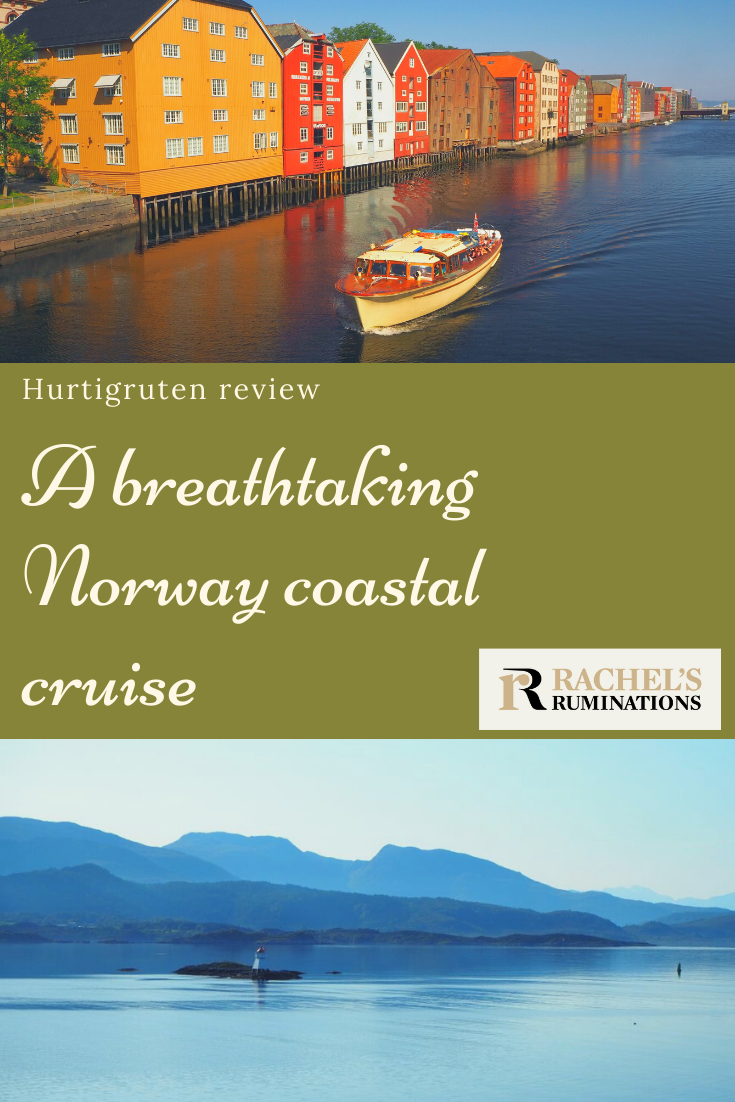


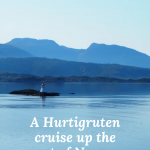
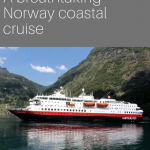
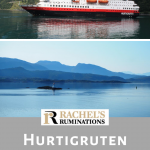
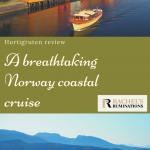

Wow! Great review of what sounds like a great trip. I’ve wanted to do one of the Hurtigruten cruises for a long time – now I really think I need to do it! But what I’m really interested in is your drive through Sweden and Finland — that’s a possibility for next summer, so am looking to see what you thought!
I’ll write about that at some point. It sort of paled in comparison with the landscape in Norway!
A very fair review. We completed a 12 day Bergen-Kirkenes round trip on Nordkapp at the beginning of May and I loved every minute of it. Like you, my husband chose not to go on any excursions, whilst I only joined the bird watching one – mainly because they were so pricey. I too was glad I went on my chosen excursion, for similar reasons to those articulated by Albert (we also saw reindeer and even some seals snoozing beside the island we circumnavigated); however, I was disappointed that we were a little early for the puffins (though saw a few beside the boat, frolicking in the waves), and felt that it would have been good to have a guide on the boat who knew a little more than simply identifying the birds. I’ve visited gannet colonies and both South Africa and Aotearoa New Zealand, and am in awe of these elegant creatures. The guides at the Hawkes Bay Cape Kidnappers’ Gannet Tour are extremely knowledgeable about the life cycle of gannets, their mating, nesting, and social behaviours, and I was expecting that level of information to be provided by our guide on the boat. Sadly it wasn’t. Interesting that you used the VoiceMap app – I relied on the research my husband had conducted prior to the trip, and we ended up visiting some really interesting places, simply because we were curious about what we saw (Tromso’s beautiful public library a standout in this regard).
Yes, my husband said similar about the excursion, but he loved seeing all those birds. The general consensus seems to be that the excursions are very pricey but nevertheless worth it. If/when I do a Hurtigruten cruise again, I’ll do better research ahead of time and maybe splurge on an excursion or two. I didn’t regret it though. I was enjoying being on the ship so much that I was kind of glad that I didn’t take any excursions.
I always wanted to know more about Hurtigruten cruises because Norway is one of the most enticing places to go to. You wrote a very interesting, honest and detailed review. The scenery is very beautiful and it shows in your photos. Now, I am convinced that Hurtigruten cruise is a great way to see the beauty of Norway. We will include it in our travel itinerary. Thank you for sharing your article.
This is an excellent review, Rachel, with insights into a type of marine travel that sounds like a fascinating alternative to traditional cruising. It’s also easy to see why you couldn’t put your camera down along the way. Gorgeous scenery, beautifully captured!
Thanks, Anita! I think if I went in the winter I’d also get great pictures, but perhaps not so many because going outside would involve bundling up for the cold!
Thanks for this review of the Hurtigruten ships. This is the kind of cruise my husband will love perhaps. He doesn’t like the huge ocean cruise liners. And Norway is a great country for amazing scenery. Do you think a winter tour would be more amazing (or late fall and early spring)?
There’s a Facebook group called Hurtigruten Insiders that you might want to join. People on there say that it’s wonderful in the winter.
This is a spectacular review! As I read, questions popped into my head, and you answered them with the next section. SO INFORMATIVE! And your photos are stunning! Thank you for planning a bucket list trip for me. 🙂
Thanks for your honest review of Hurtigruten Cruise Line. It’s nice t see all of the beautiful images that accompany your article. To often we find articles written that do not represent the true experiences that we would have once on-board. You have made it quite obvious where and what this cruise includes.
Thanks Jeff and/or Crystal!
Great review of an awesome cruise from the looks of it. I like the size of the ship as l am not too crazy on the gigantic ones even though l have been on them. The food looks amazing and the rooms looks a bit more spacious than normal. I’m glad you and the hubby were able to come to a compromise and take the Hurtigruten cruise. Thanks for sharing, I might just have to add it to the every growing list. 🙂
Yes, I fear this may have ruined me for normal large-scale cruises!
Your Norwegian coast cruise with Hurtigruten looks fabulous. I do think I would enjoy it. I like that it is “downscale.” Your photos are enticing, and your descriptions and advice are priceless. I’ll be re-reading this when I take the same cruise someday.
Thanks, Carole!
I really enjoyed reading all about this cruise experience. I’ve only been on a couple of other cruises and they were quite different than this one. The scenery looks amazing.
Wonderful and detailed review of the Hurtigruten cruise. You mentioned a 4-day version. I don’t see it on the website; only the 12-day round trip and the North Cruise which is 7 days and South Cruise which is 6 days. Is there a 4-day cruise From Bergen to Tromso? Thanks.
What I meant was that you don’t have to travel the whole route: you can book just from Bergen to Tromso. Locals often use the boat for local travel, just getting on for a few stops, for example.
Hi, I wonder if you get only 2 hours in a city is it enough to go offshore, explore a bit the ity and come back, Alasud Tromso ,trondheim and bergen besides 2 fjords my porints of interest . Usually cruise ships stay in a place 6 -7 hours so you do not have a sense of urgency Please advice, We are planning to go end of September
This is not a cruise ship and the stops are short. We had about three hours in Trondheim and even less in Tromso. Bergen is the start or end-point of this route, so you can have as much time there as you want. In both Trondheim and Tromso we had enough time to take a walk and see the main sights, but only very quickly. What you might think about doing, if you want more time in either or both cities, is book the trip so that you get off, stay a night, then take the next boat the next day. That would give you 24 hours in each city, or more if you stay more nights. Remember one boat leaves every day going north and one boat leaves every day going south, and Hurtigruten allows you to book this way. Just a suggestion! Have a great trip!
You destructive imbosiles should keep out of the Antrctica ,the likes of your company are destroying the planet with the human footprint on pristine remote areas.i despise your lack of integrity and disregarde for wilderness areas inthe name of making money shame.
This was a cruise along the coast of Norway, not to Antarctica. And I’m not Hurtigruten, so you’re criticizing the wrong person. Direct your anger – not with insults but with reasoned argument – at the company, not at me. In their defense, I think they’re one of the most environmentally aware companies visiting Antarctica and they’re definitely ahead of the curve on sustainability as well.
Thank you, this is very helpful! I am scheduled on a Hurtigruten voyage in June, and chose them because I also don’t like traditional cruises but want to see the fjord scenery. All of your info is much appreciated!
I’m glad it was of use! Enjoy your trip! (I admit to being a bit jealous…)